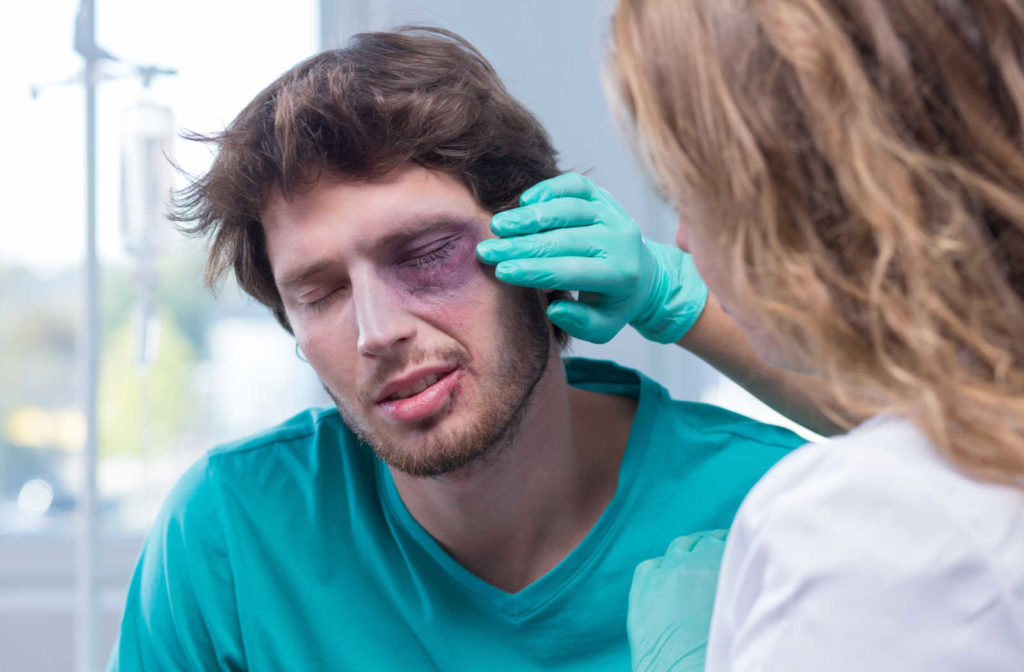Dry eyes can result in symptoms like light sensitivity, itchy or bloodshot eyes, and in some cases, even mucus discharge. However, there is no clear evidence that dry eyes can cause floaters or that they are a symptom of the condition.
If you are experiencing any discomfort resulting from dry eyes or floaters, make sure to book an appointment with In Focus Eyecare and have an experienced optometrist conduct an evaluation.
Do Dry Eyes Cause Floaters?
As of today, there has been no verified link between dry eyes and floaters. They share some similar qualities and risk factors, which has resulted in some speculation about their connection.
For example, you may experience the two conditions around the same time, as they tend to develop with age. Additionally, the two can result from a medical condition, illness, or trauma caused to the eyes.
What Are Floaters?
Floaters are very small dark specks or squiggles that can appear in your field of vision. They can be in various shapes or sizes and actually reside within the gel inside of your eye. Floaters’ movement tends to follow the general movement of your eyes. It is not abnormal to have some floaters within your eye. However, you should have your eyes assessed when they first appear as in some circumstances they are due to retinal tears or detached retina. This is truly urgent as a retinal detachment can be sight threatening.
Causes of Floaters?
If you’ve noticed some small dark specks or squiggles inside your eye that move around or resemble cobwebs, you have floaters. Let’s discuss some of the ways that they can be detected, caused, and treated.
How are floaters managed?
When floaters are first detected, do a self assessment. Determine which eye is seeing them and their location in your field of vision. Then call for an examination by one of our eye care specialists. During this exam, eye drops will be put in to dilate your pupils. This permits a full assessment of the vitreous gel and retina. Your doctor will then determine the best care and explain it to you in appropriate detail.
Causes
There are several ways that floaters can come to exist within your eyes. Nonetheless, here are a few of the more common causes:
- Retinal tear or detachment – you must seek urgent care as these conditions can be sight threatening. Call our office or go to the Emergency Department at your nearest hospital
- Small flecks of matter or protein that became stuck within the vitreous before birth
- Floaters that develop with age through changes in the vitreous gel inside your eye
- A traumatic event or injury caused to the eye
- Certain medical illnesses or medications
Treatment
In most cases, floaters disappear gradually with time and will not need treatment or to be removed. However, if they are causing issues with your vision, it is important to book a consultation. Here are some of the options that could be available to you:
- Surgery performed by an ophthalmologist to replace the solution within the vitreous
- Laser therapy can be done to split up the floaters and help make your vision less cloudy

What is Dry Eye?
Dry eye is a condition in which the eyes lack proper lubrication and dry too quickly. It could be the result of insufficient tears or in some cases producing an excess amount of tears. An examination with your eye care doctor will allow them to measure the quality and quantity of your tears to help determine if you are experiencing dry eye.
Symptoms
Here are some of the common symptoms that are associated with dry eyes:
- Intermittent blurry vision
- Stinging, burning, or general discomfort in the eyes
- Red eyes
- Sensitivity to light
- Discomfort wearing contact lenses
- Glare while driving in the dark
Causes of Dry Eye
Dry eye is not uncommon, and it is estimated that around 30% of Canadians have experienced symptoms of the condition at some point. That being said, it can cause discomfort, and it is crucial to seek professional help if you are experiencing any of the symptoms listed above.
In most cases, people have dry eyes due to decreased tear production or increased tear evaporation:
Decreased Tear Production
Decreased tear production refers to the body finding it challenging to produce enough tears and keep the eyes properly lubricated.
Here are some of the common reasons you might experience decreased tear production:
- Aging
- Certain medications
- Nerve damage or laser eye surgery
Increased Tear Evaporation
Increased tear evaporation refers to clogged meibomian glands on your eyelids and causes the tears to evaporate too quickly.
Here are some of the common reasons you might experience increased tear evaporation:
- Side effects of rosacea and other skin disorders
- Screen time: we all tend to stare at our screens. If done chronically, dry eye issues can arise
- Allergies
- Vitamin A deficiency
Treatment
If you are experiencing dry eye symptoms, you should book an appointment with an eye care specialist and have them assess what might be causing the problem. Some of the typical treatment methods include:
- Drops: artificial tears and or medicated drops targeting reduced inflammation
- Procedures: IPL, RF and or iLux procedures can improve tear function
- Special contact lenses
- Dealing with any underlying medical conditions that might be causing the dry eye symptoms.
Book a Consultation
Please make an appointment with In Focus Eyecare; our friendly staff and optometrists will be happy to help! In the meantime, you can visit our online shop and pick up some artificial tears to help relieve discomfort.





